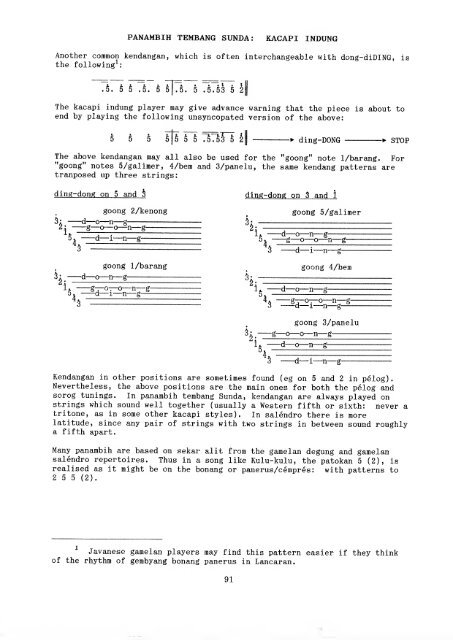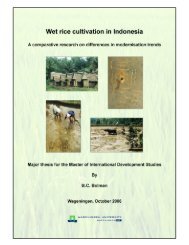Guide to Sundanese Music - Free EBooks Library
Guide to Sundanese Music - Free EBooks Library
Guide to Sundanese Music - Free EBooks Library
You also want an ePaper? Increase the reach of your titles
YUMPU automatically turns print PDFs into web optimized ePapers that Google loves.
PANAMBIH TEMBANG SUNDA: KACAPI INDUNG<br />
Another common kendangan, which is often interchangeable with dong-diDING, is<br />
the following :<br />
.5. 5 5 .5. 5 5 .5. 5 .5.53 5 2<br />
The kacapi indung player may give advance warning that the piece is about <strong>to</strong><br />
end by playing the following unsyncopated version of the above:<br />
h 5 515 5 5 75753 t k\ - ding-DONG -»• STOP<br />
The above kendangan may all also be used for the "goong" note 1/barang. For<br />
"goong" notes 5/galimer, 4/bem and 3/panelu, the same kendang patterns are<br />
tranposed up three strings:<br />
ding-dong on 5 and h<br />
-d—<br />
2: g—<br />
g (J—<br />
'S<br />
S: d— 2:<br />
o— n—<br />
i— n<br />
goong 2/kenong<br />
o— o—n—<br />
o— n—<br />
1 -o—-o— n-<br />
5 d— 1— n—<br />
^3<br />
goong 1/barang<br />
g<br />
ding-dong on 3 and 1<br />
h.<br />
li. d— o— n-<br />
^5<br />
-o—<br />
4,<br />
3 .<br />
^<br />
goong 5/galimer<br />
-d—<br />
o— n— g-<br />
i— n—<br />
goong 4/bem<br />
-d— o— n-<br />
^6 g-r-o-r-o— n-<br />
3 d— 1— n—<br />
g— o— o—<br />
I d—<br />
^4<br />
S d—<br />
goong 3/panelu<br />
o— n— g-<br />
-<br />
i— n-<br />
Kendangan in other positions are sometimes found (eg on 5 and 2 in pelog).<br />
Nevertheless, the above positions are the main ones for both the pelog and<br />
sorog tunings. In panambih tembang Sunda, kendangan are always played on<br />
strings which sound well <strong>to</strong>gether (usually a Western fifth or sixth: never a<br />
tri<strong>to</strong>ne, as in some other kacapi styles). In salendro there is more<br />
latitude, since any pair of strings with two strings in between sound roughly<br />
a fifth apart.<br />
Many panambih are based on sekar alit from the gamelan degung and gamelan<br />
salendro reper<strong>to</strong>ires. Thus in a song like Kulu-kulu, the pa<strong>to</strong>kan 5 (2), is<br />
realised as it might be on the bonang or panerus/cempres: with patterns <strong>to</strong><br />
2 5 5 (2).<br />
Javanese gamelan players may find this pattern easier if they think<br />
of the rhythm of gembyang bonang panerus in Lancaran.<br />
91








